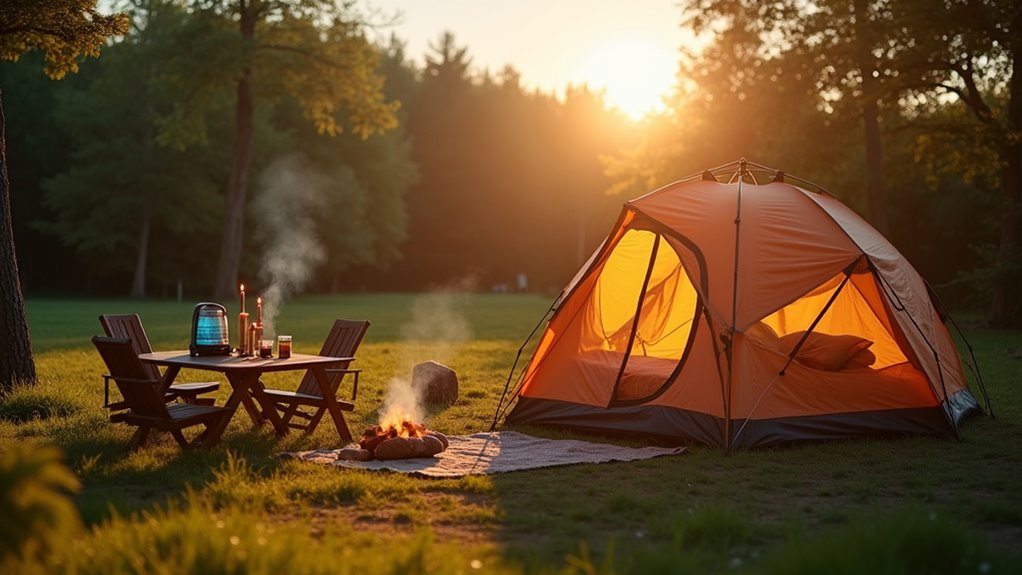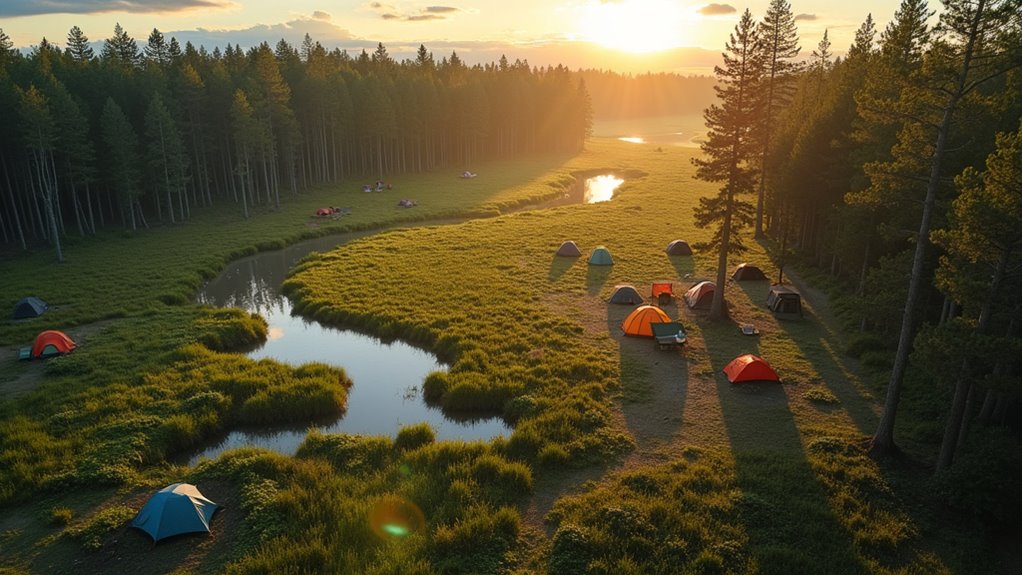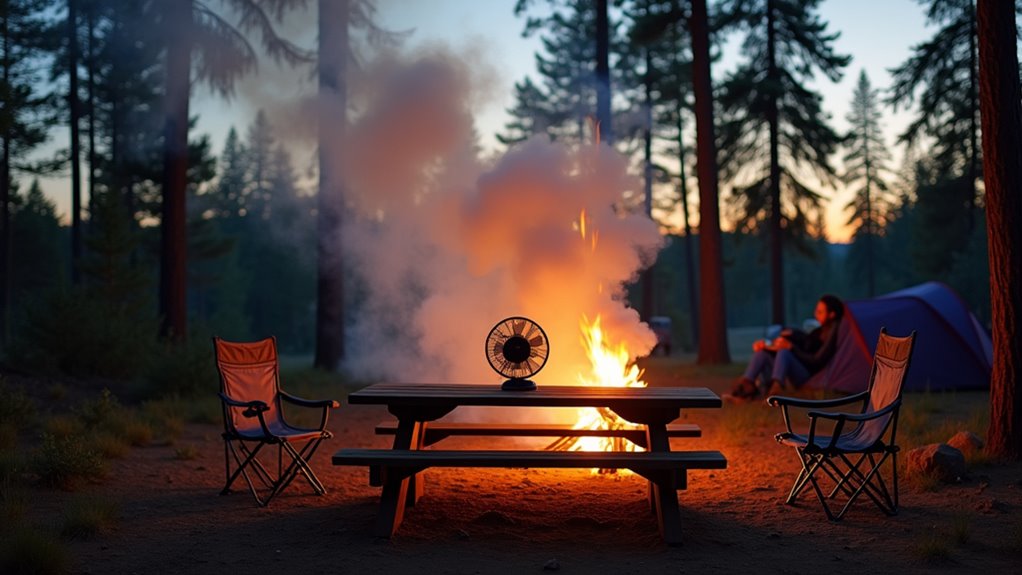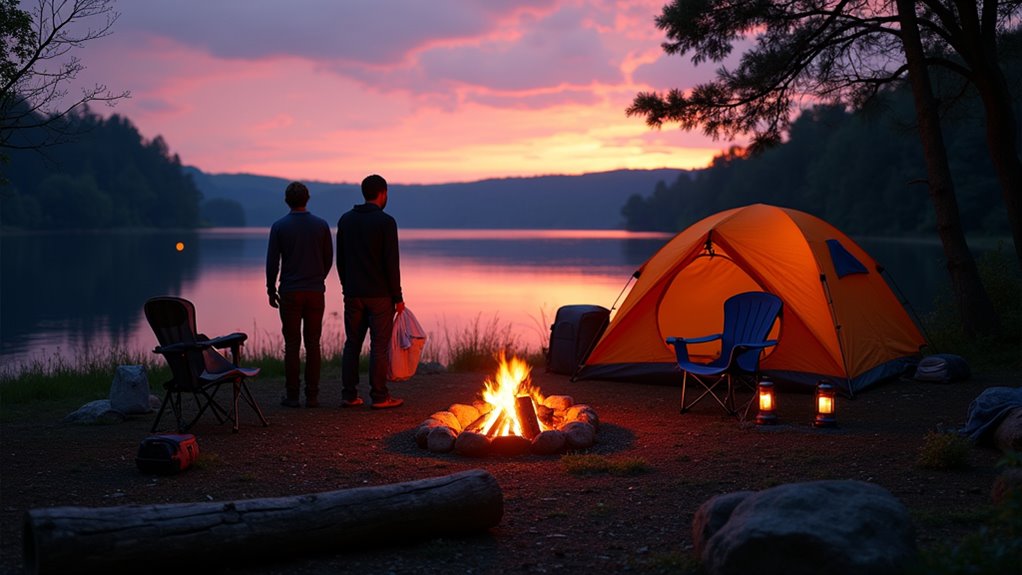Physical Address
304 North Cardinal St.
Dorchester Center, MA 02124
Physical Address
304 North Cardinal St.
Dorchester Center, MA 02124

Outsmart mosquitoes with these 7 proven camping strategies that go beyond basic repellent—discover the secret method most campers never try.
You probably don’t realize that mosquitoes can detect your breath from up to 50 feet away, making traditional hiding spots nearly useless. While most campers focus on swatting and spraying after these pests arrive, smart outdoor enthusiasts know there’s a better approach. These seven proven strategies won’t just reduce mosquito encounters—they’ll transform your camping experience from a constant battle into the peaceful retreat you’ve been hoping for.

Before you even pitch your tent, you can dramatically reduce your mosquito encounters by selecting the right spot. Avoid camping near stagnant water sources like ponds, marshes, or slow-moving streams where mosquitoes breed. Instead, choose elevated areas with good airflow – mosquitoes are weak fliers and struggle in breezy conditions.
Look for campsites away from dense vegetation where mosquitoes hide during daylight hours. Open meadows or clearings work better than thick forest areas. If you’re car camping, consider sites with gravel or sandy surfaces rather than grassy areas that retain moisture.
Scout your potential campsite during late afternoon when mosquito activity peaks. This’ll give you a realistic preview of what you’re facing. Remember, spending five extra minutes choosing your spot can save hours of swatting and itching later.
Strategic campsite selection is one of the most effective camping hacks that experienced outdoor enthusiasts swear by for mosquito prevention.
Once you’ve picked your ideal spot, it’s time to create a mosquito-proof fortress around your sleeping area. Your tent’s your first line of defense, so check for holes and repair them with duct tape before heading out. Pack a quality sleeping bag that zips completely shut – gaps are mosquito highways.
Your tent is your fortress, but only if it’s sealed tight – even the tiniest gap becomes a mosquito superhighway.
Consider bringing lightweight mosquito netting to drape over your camping chairs and cooking area. You can find affordable options at most outdoor stores.
Long-sleeved shirts and pants become essential armor during dawn and dusk when mosquitoes are most active.
Don’t forget a wide-brimmed hat to protect your head and neck. Tuck your pants into your socks – it looks dorky but works brilliantly. These simple barriers cost little but deliver massive protection against persistent buzzing invaders.
In regions where mosquito-borne diseases are prevalent, mosquito nets become absolutely crucial for protecting campers from potentially serious health risks.

Physical barriers work wonders, but you’ll want backup protection that doesn’t rely on synthetic chemicals or drain your wallet. Essential oils pack serious mosquito-fighting power without breaking the bank. Mix 10-15 drops of peppermint, eucalyptus, or lemon oil with water in a spray bottle for instant repellent.
Citronella candles create protective zones around your campsite while adding ambient lighting. Plant-based options like neem oil offer hours of protection when applied to exposed skin.
You can also crush fresh mint leaves and rub them directly on your arms and legs. Vanilla extract works surprisingly well – dab it behind your ears and on pulse points. These natural alternatives smell pleasant, won’t irritate sensitive skin, and cost a fraction of commercial repellents.
While natural repellents offer gentle protection, commercial insect repellents deliver the heavy-duty defense you’ll need in mosquito-heavy environments. Choose products containing DEET, picaridin, or permethrin for maximum effectiveness. DEET concentrations between 20-30% provide 6-8 hours of protection without breaking your budget.
Apply repellent to exposed skin and clothing, but skip areas under your clothes. Don’t forget often-missed spots like ankles, wrists, and behind your ears.
Reapply every 4-6 hours or after swimming and sweating heavily.
For extra savings, treat your camping clothes with permethrin spray before your trip. One treatment lasts through multiple washes.
Combine skin repellent with treated clothing for double protection that’ll keep mosquitoes at bay all night long. When camping at high altitudes like Mount Kilimanjaro, mosquito pressure typically decreases significantly as you gain elevation.

Two natural forces work as your cheapest mosquito deterrents: smoke and moving air. Build your campfire upwind from your seating area so smoke drifts over you naturally. Mosquitoes hate smoke and will avoid smoky zones entirely. Don’t have firewood? Burn sage, rosemary, or citronella leaves for effective smoke without a large fire.
Create a natural mosquito barrier by positioning your campfire upwind so smoke drifts over your seating area.
Moving air disrupts mosquitoes’ weak flying abilities. Position battery-powered fans around your campsite or hang them from tent poles. Even gentle breezes make it nearly impossible for mosquitoes to land on you.
Set up camp in naturally breezy spots like hilltops or open meadows when possible.
Combine both methods by positioning yourself between your fire and a fan. This creates a double barrier that’ll keep mosquitoes away without spending money on expensive repellents. These strategies also help prevent bug bites from other flying insects that plague campers during outdoor adventures.
Since mosquitoes need just a bottle cap’s worth of water to breed, you’ll want to scout your campsite for any pools, puddles, or containers that collect moisture. Check around your tent, coolers, and gear for anything that’s collected rainwater or condensation. Empty out cups, bowls, and buckets that aren’t in use. Look for natural depressions in rocks or logs where water might pool.
If you can’t drain certain areas, disturb the water surface regularly by stirring it with a stick. Moving water won’t support mosquito larvae development.
Also inspect your campsite’s perimeter within a 50-foot radius. Even small puddles from recent rain can become breeding grounds within days. This simple prevention step costs nothing but markedly reduces mosquito populations around your camp. When hiking trails like Scotland’s West Highland Way, these water elimination techniques become especially important in the damp Highland climate where standing water accumulates frequently.

Beyond eliminating breeding spots, you can outsmart mosquitoes by working around their natural schedule. These blood-sucking pests aren’t equally active throughout the day – they follow predictable patterns you can exploit.
Mosquitoes are most active during these peak times:
Plan your hiking, fishing, or camp setup during mid-morning through late afternoon when mosquito activity drops considerably.
If you must venture out during peak hours, wear long sleeves and apply repellent beforehand.
Stay inside your tent or screened shelter when possible during these high-risk periods.
Whether you’re planning adventure camping or seeking a more relaxing outdoor experience in destinations like Alpine, Wyoming, timing your activities strategically will significantly improve your mosquito-free camping experience.
You’ve got the battle plan—now it’s time to execute. Think of these strategies as your anti-mosquito armor, each layer adding protection without breaking the bank. Don’t let these buzzing bandits turn your outdoor paradise into a swatting marathon. Mix and match these budget-friendly tactics like a seasoned camper’s toolkit. With smart planning and a few dollars spent wisely, you’ll transform your campsite from mosquito magnet into your peaceful outdoor sanctuary.